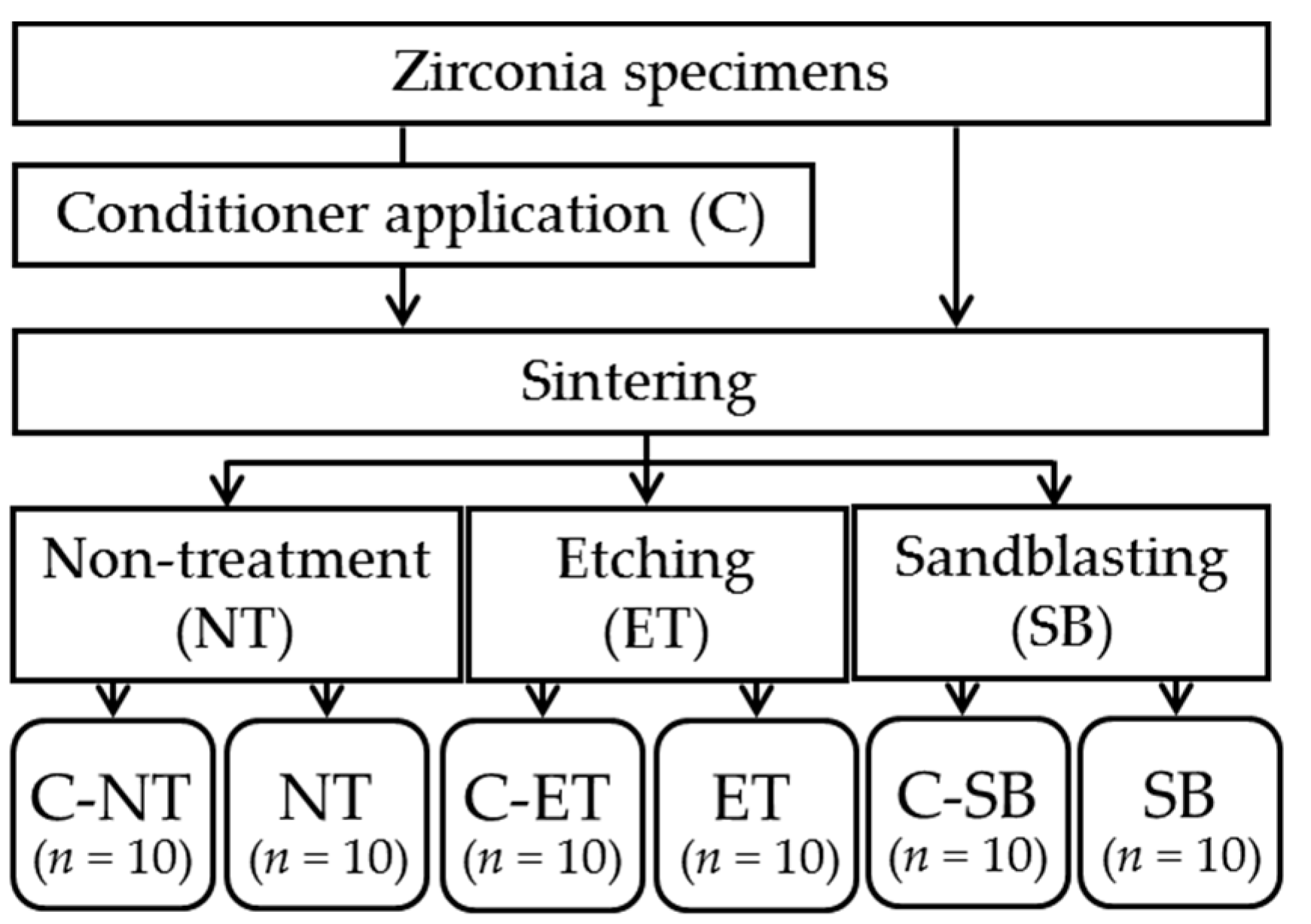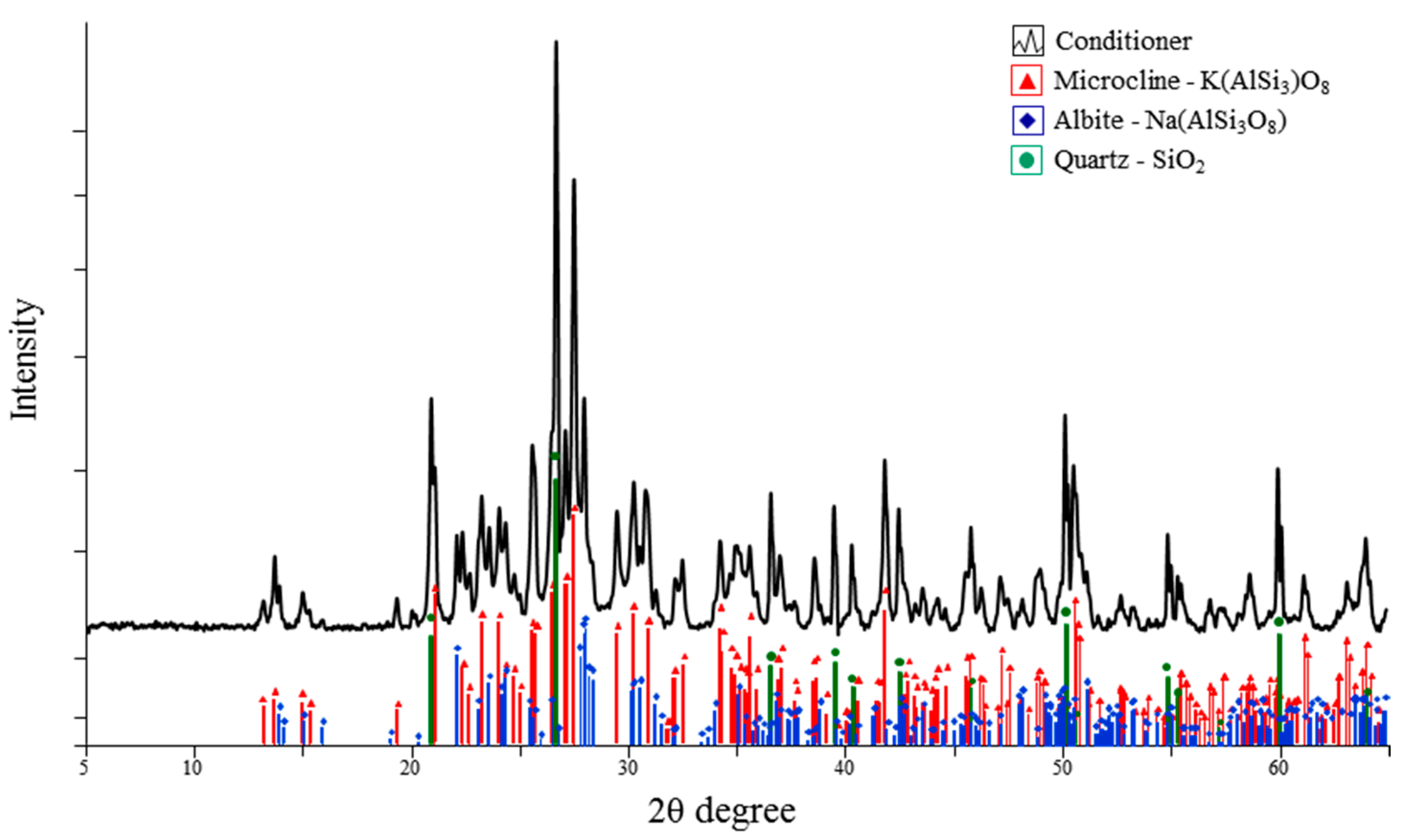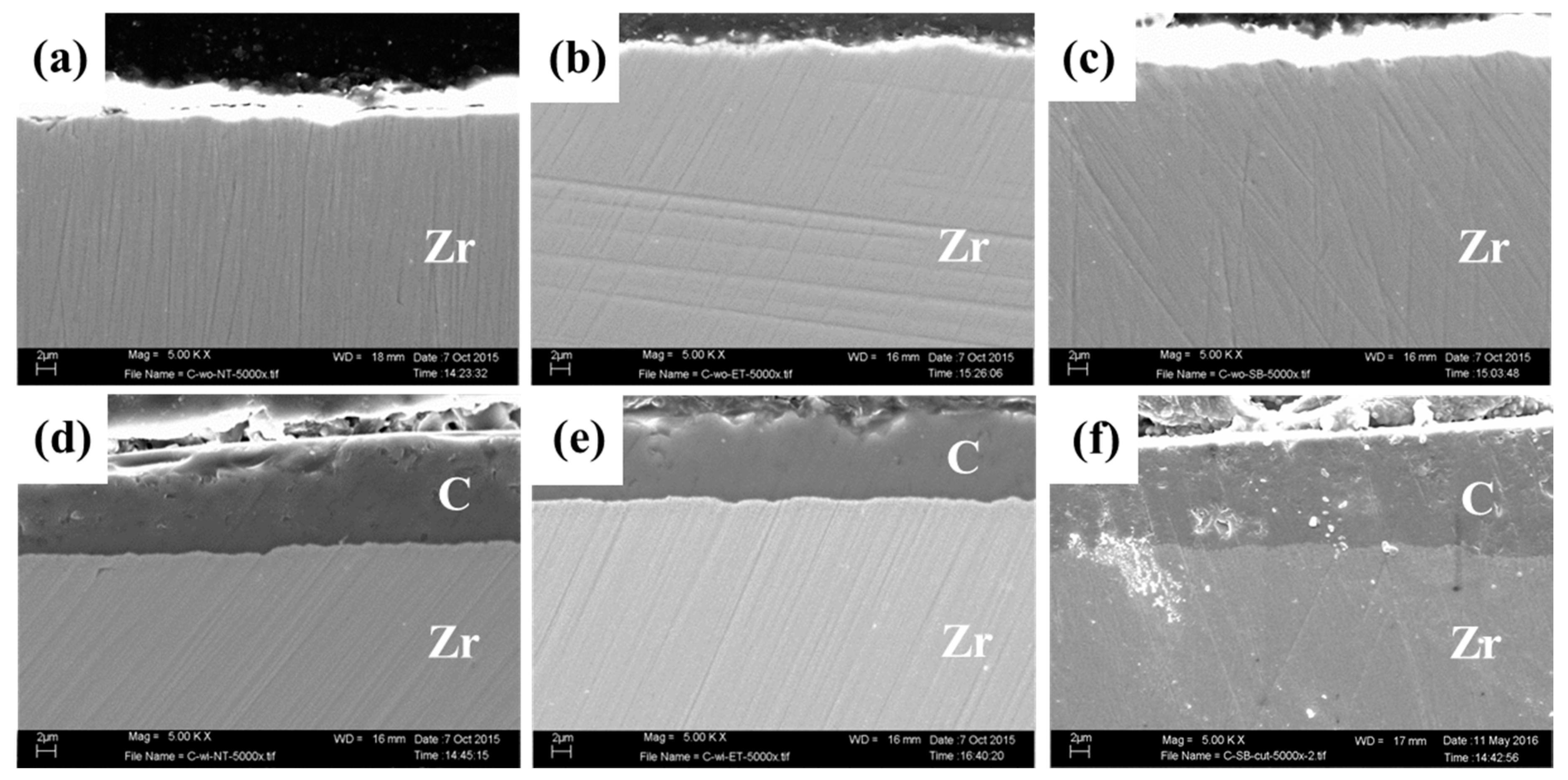1. Introduction
Zirconia-based all-ceramic restorations have been used successfully in dental clinics along with dental computer-aided design/computer-aided manufacturing (CAD/CAM) systems [
1]. Zirconia is one of the most promising restorative materials because it shows very favorable mechanical properties and reasonable esthetics [
2]. The clinical performance of zirconia-based fixed partial dentures (FPDs) showed a similar survival rate compared with that of metal-ceramic FPDs in the short- and medium-term [
3,
4]. Unfortunately, biological and technical complications have been generally confirmed, not only for all-ceramic restorations, but also for metal-ceramic restorations. The most common complications in bilayered porcelain/zirconia crowns have been identified as loss of retention, endodontic treatment, fractures of veneering ceramics, and bleeding on probing [
5]. Moreover, chipping of veneering ceramics on zirconia-based FPDs was higher compared with that of metal-ceramic FPDs [
6]. Likewise, in in vitro reports, the bond strength between metal and veneering ceramics was higher compared with that between zirconia and veneering ceramics [
7].
For achieving long-term clinical success, various approaches have attempted the improvement of the bonding between zirconia and either veneering ceramics or cement materials [
8,
9,
10,
11,
12,
13]. Modification of the zirconia framework and sandblasting (airborne abrasion) of zirconia surfaces have been recommended to improve the fracture resistance of veneering ceramics [
8,
9]. On the other hand, for bonding of zirconia to cement materials, an in vitro systematic review summarized seven surface treatment methods with 23 different procedures [
10]. Generally, a tribochemical method such as sandblasting with alumina (Al
2O
3) particles has been used to adapt the zirconia surface [
11,
12]. Furthermore, silanization by silane coupling agents or universal adhesive primers after silicatization has improved zirconia bonding to cement materials [
11]. The combination of sandblasting followed by a universal primer contributed to zirconia bonding with resin cements that contain phosphate ester monomer 10-methacryloyloxydecyl dihydrogen phosphate (MDP) [
12]. However, shear bond strength (SBS) was influenced by Al
2O
3 particle sizes and universal primer products [
13]. A recent systematic review summarized the correlation between in vitro studies and clinical studies [
14]. This report indicated well-established clinical evidence that sandblasting at a moderate pressure and using primers containing phosphate monomer and/or luting resins provide long-term durable bonding to zirconia. In addition, alternative approaches i.e., laser, acid, and low-fusing glaze porcelain coating treatments have been introduced [
15,
16,
17]. However, the clinical evidence of these alternative methods is yet unclear. Kern [
14] suggested that the aforementioned alternative bonding systems might be reconsidered because these methods were more time consuming or require rather complicated and technique sensitive procedures.
A simple alternative approach was developed utilizing a novel conditioner (mixture of silicate ceramic and quartz) to pre-sintered zirconia for promoting the adhesion between oxide ceramics and veneer ceramics [
18]. Our previous study has already shown a decrease of adhesive fractures between zirconia coated with this novel conditioner and veneering ceramics [
19]. This procedure can save working time because an experimental conditioner is just applied on the zirconia surface before sintering. If this conditioning method would also improve the bonding between zirconia and cement material at the same time, this might reduce both major clinically relevant technical complications i.e., fracture of veneering ceramics and loss of prostheses retention. Thus, the evaluation of the bonding between zirconia coated with this novel conditioner and cement material is needed.
Therefore, the aim of this study was to analyze bonding via SBS testing between conditioner-coated zirconia surfaces modified with three different treatments and resin cement. The null hypotheses were that the conditioner-coated zirconia followed by either sandblasting or etching would neither improve the shear bond strength nor the failure mode, irrespective of thermocycling.
4. Discussion
The focus of this study was to evaluate the effect of a specific conditioner application to pre-sintered zirconia surfaces on bonding to resin cement. The terms conditioner and primer are not clearly defined in the literature. In our study, the term conditioner is strictly used for the pre-sintered stage. The term primer is used in the field of cement bonding only. Without thermocycling, SBS values in the sandblasted specimens (the C-SB and SB groups) were higher than those in other groups. Adhesive fractures were commonly observed in the specimens, except in the C-SB group. After thermocycling, all groups showed significantly decreased SBS values; however, the C-SB (+) group showed the highest SBS value. In addition, adhesive fractures occurred in all groups; however, the C-SB (+) group partially showed mixed fractures. Thus, the first and second null hypotheses were rejected.
Conditioner application affected the surface roughness parameters and changed the morphology. For the surface roughness parameter
Ra and
Rmax, the conditioner-coated specimens showed significantly higher values than the conditioner-free specimens. In particular, the C-NT group showed a four-fold rougher surface than the NT group. Other surface roughness parameters (
Rsk and
Rpm/
Rz) were also used to clarify the surface morphology. The
Rsk and
Rpm/
Rz values in the C-NT group were significantly higher than those in the NT group (
Table 4). From these results, the surface of the C-NT group was characterized as a sharp, rough surface. Our
Ra results of the C-NT group are in agreement with those of a previous study [
25]. An experimental glass slurry coated onto zirconia surfaces before sintering caused a significant increase in
Ra because the slurry contents adhered to the surfaces after sintering. The experimental conditioner, studied here, contained silicate ceramics and quartz as shown by XRD and XRF (
Figure 2,
Table 3), and was adhered onto the surfaces of the C-NT group as confirmed by SEM-EDX (
Figure 3d).
Moreover, conditioner-coated specimens affected the water contact angles which were significantly decreased compared with conditioner-free specimens. This finding may be supported by a previous study showing that the contact angle of a Si-based thin film coated zirconia surface was significantly lower than those of non-coated and silica-modified Al
2O
3-sandblasted surfaces [
26]. Their film coating by magnetron sputtering technique could obtain a strong chemical bonding to the zirconia surface as a homogeneous layer without a change in surface roughness. In contrast, our application method induced a rough surface and decreased the contact angle in the C-NT group. This difference was due to the application system. In our study, slurry conditioner components were not uniformly distributed on the zirconia surface by manual coating. This resulted in weaker chemical bonding compared with a film coating method, but led to the micromechanical retention by a rough surface.
Morphological changes occurred on both conditioner-coated and uncoated specimens by the respective subsequent surface modifications. Sandblasting has been recognized as a standard modification for zirconia in both in vitro and clinical systematic reviews [
10,
14]. In general, sandblasting which caused an increase of surface roughness and modified the wettability, improves the micromechanical retention [
13]. Surface roughness in the SB group increased the
Ra and
Rmax values compared with those in the NT group. These findings were confirmed by the SEM-EDX results; Al, which is a component of the sandblasting particles, was detected on the surfaces of the SB group, whereas it was not detected on the surfaces of the NT group (
Figure 3a,c). This behavior was also reflected by other surface roughness parameters, showing a negative skew (
Rsk: <0), and changed the rounded profile (
Rpm/
Rz: <0) in the SB group. These tendencies of surface changes also occurred in the C-SB group. The C-SB group showed significantly lower
Rsk and
Rpm/
Rz values compared with the C-NT group although there was no significant difference in
Ra and
Rmax values. From these findings, the conditioner layer was diminished, but still could be observed in the surface of the C-SB group after our moderate sandblasting procedure (
Figure 4f).
HF etching is a conventional method to change the microstructure and obtain the appropriate microstructure for bonding in feldspathic ceramics [
27]. In contrast, the dense crystal network of zirconia is resistant to chemical treatments [
28]. However, recent reports have shown that zirconia can be etched under certain conditions i.e., a high HF concentration (48%), a long application time (0.5–24 h), and high temperature (80 °C) [
16,
29]. Our results of
Ra and
Rmax in the ET group indicated increased surface roughness compared with those in the NT group. In the C-ET group, etching had only a minor effect on the conditioner layer, as shown by the SEM-EDX analyses and all surface roughness parameters that were similar to those in the C-NT group. Thus, our results show that the conditioner application influenced the surface characteristics more than sandblasting or etching.
The SBS values of the sandblasted specimens exhibited higher strength than those of etched or non-treated specimens in the non-thermocycled condition, irrespective of conditioner application. In particular, the ET and C-ET groups showed the lowest SBS. These results were in agreement with a previous report by Smielak et al. [
30]. The surface roughness (
Ra) of zirconia changed at the nanometer level after 40% HF etching for 15 min, which might have resulted in less bonding to luting resin cements. Sriamporn et al. [
16] reported that the lower bond strength could be explained by the high viscosity of the resin cement, which cannot penetrate into the nano-pores of the etched zirconia surface. Furthermore, a tetragonal-to-monoclinic phase transformation was induced in the etched zirconia surface, which may lead to crack propagation and reduced mechanical properties [
16,
31]. In our study, a micromechanical bond could not be obtained completely between the nano scaled zirconia surface and resin composite in the ET and C-ET groups.
Conversely, in the SB and C-SB groups, an explanation may be that resin cement can penetrate into the micro-scaled surface of the sandblasted zirconia to obtain micromechanical interlocking in contrast to etching. This positive effect is dependent on the sandblasting conditions, i.e., the blasting material, particle size, and application time. Using 50 µm Al
2O
3 particles at a moderate pressure (0.25 MPa) was recommended on clinical evidence [
14]. Our sandblasting condition was similar with their report. However, adhesive fractures were observed in the SB group in spite of the presence of the residual resin cement (
Figure 6c), whereas mixed fractures were partially observed in the C-SB group. This difference may be caused by conditioner application and by sandblasting because micromechanical interlocking and chemical bonding in the silica-free zirconia surface (the SB group) seemed to be insufficient compared with those in the C-SB group. In general, a strong resin bonding relies on micromechanical interlocking and adhesive chemical bonding to the ceramic surface, requiring surface roughening for mechanical bonding and surface activation for chemical adhesion [
30].
Thermocycling or/and long-term water storage were used as conditions to simulate the aging of resin bonding [
32]. Water may penetrate the network and cause the composite to expand. This state is reached when the weight of the material stops increasing. It may take several weeks until a material has expanded to its maximum. According to ISO 4049 [
33] water sorption must be below 40 µg/mm
3 after seven days. In many bond strength studies, a preliminary storage in water is carried out 24 h [
10]. In this study, time for water absorption during thermocycling was seven days. Even if a full water absorption has not been reached, the aging process performed here gives a first indication of the long-term stability. Different degrees of debonding were observed in all experimental groups after thermocycling. An explanation might be that aging degradation induced cement debonding from microleakage. In particular, all specimens were debonded in the NT (+), C-NT (+), and C-ET (+) groups because etched and non-treated surfaces showed lower mechanical retention than sandblasted surfaces. Comparing effects of conditioner applications, the C-SB (+) group showed a lower decrease in SBS and a higher degree of mixed fracture compared with the SB (+) group. Thus, the higher mechanical retention of a sandblasted zirconia surface was effective for subsequent resin bonding as mentioned above. For the sandblasted zirconia surface, the combination of primers containing phosphate monomer and/or luting resins was recommended from clinical outcomes [
14]. In an in vitro study, the application of various universal primers (adhesives) for chemical bonding was effective on sandblasted zirconia surfaces to improve bonding to resin cement after aging [
13], as only sandblasted and silanated surfaces showed a significant decrease in the SBS values [
32]. One universal primer product might affect hydrolytic degradation and thus nullify the advantage gained from increased micromechanical retention after aging. However, Monobond Plus (Ivoclar Vivadent GmbH, Ellwangen, Germany) did not influence the hydrolytic degradation [
13]. For the sandblasted zirconia surface, the combination of Monobond Plus and MDP-based self-adhesive cement showed aging resistance [
34,
35]. Thus, the combination of Monobond Plus and Panavia SA Cement Plus Automix (Kuraray Europa GmbH, Hattersheim am Main, Germany) was used in this study.
To sum up, the C-SB group has the potential for both strong micromechanical interlocking and chemical bonding compared with all other experimental groups, and showed improvements in bond strength and failure mode.
Recently, different modification methods of pre-sintered zirconia for the improvement of bonding were reported in in vitro studies [
9,
36,
37]. Sandblasting prior to zirconia sintering increased the surface roughness and bond strength to veneering ceramics compared with that after sintering [
9]. Actually, there are risks of defects in the thin parts of pre-sintered zirconia substrates during sandblasting. Moreover, coating treatments using silica or zirconia powder on the pre-sintered zirconia did not cause a phase transformation by sintering, and enhanced the bond strength of veneering ceramics or cement [
36,
37]. Unfortunately, these coating approaches are comparably time consuming [
14]. In contrast, the novel conditioner application to zirconia surfaces following sandblasting in our study was simple, safe, and economic compared with these methods, thus indicating an advantageous method. Together with the results of a previous study [
19], the present results indicate that this approach may improve the bonding characteristics to both resin cement and veneering ceramics. Further studies are needed to clarify possible clinical applications of this conditioner.












